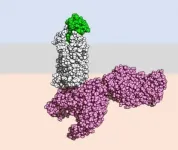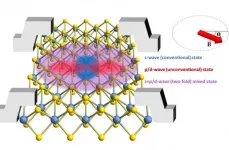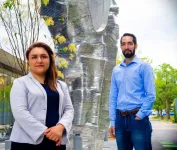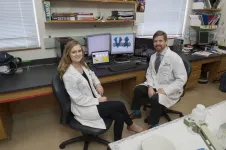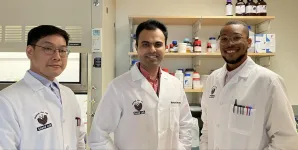(Press-News.org) Chemokine receptors, located at the surface of many immune cells, play an important role in their function. Chemokines are small proteins that bind to these receptors and control the movement and behaviour of white blood cells. However, despite the importance of this family of receptors, their activation mechanism remains poorly understood. In Switzerland, a research consortium from the University of Geneva (UNIGE), the Biozentrum of the University of Basel, and the Paul Scherrer Institute (PSI) in Villigen has succeeded in decoding the activation mechanism of the CCR5 receptor, a member of this family implicated in several diseases such as HIV/AIDS, cancer, and the respiratory complications of COVID-19. This discovery represents an important step in the understanding of chemokine receptor biology, providing valuable insights for improving new drugs that this important family of receptors. This work can be found in the journal Science Advances.
The CCR5 receptor plays a major role in inflammation and immune defence, and has long been an important target for anti-HIV drugs. "Research on CCR5 began almost 25 years ago as part of the fight against AIDS", explains Stephan Grzesiek, a professor at the Biozentrum of the University of Basel, who co-directed this work with Professor Oliver Hartley of the Department of Pathology and Immunology at UNIGE Faculty of Medicine, and colleagues from the Paul Scherrer Institute (PSI). "It is indeed fundamental to the HIV infection mechanism, but also seems to be very important in many other pathological processes, notably in cancers and inflammatory diseases. However, in order to better exploit it for therapeutic purposes, we needed to understand, at an atomic level, how activation through its binding to chemokines works."
Chemokines are small signalling molecules that play a central role in the circulation and activation of immune cells. By binding to receptors on the membrane of white blood cells, they act as guides, ensuring that the cells reach the right place at the right time, to both maintain the immune system and respond to infection or injury. But how is the receptor able to sense the docking of a chemokine at the outside the cell? And how is this activation message transmitted to the inside of the cell so that it can respond?
Visualising atomic structures in 3D
Until now, the study of this phenomenon has been hampered by the difficulty of observing the 3D structures of the receptors when bound to the molecules that activate them. To this end, the Basel team, which specialises in structural biology, used cryo-electron microscopy tools that make it possible to preserve and observe the structure of the smallest elements of living organisms. "However, in order to understand the entire process, it is necessary to make use of engineered chemokines that bind to receptors more stably than the natural ones", says Oliver Hartley. "For this, we were able to exploit the molecules that we had discovered in the course of our HIV drug research." And indeed, some of these variants over-activate the receptor while others block them entirely.
The right key to fit in the lock
The receptor, which is embedded in the cell membrane, works like a "lock and key" mechanism. A specific part of the chemokine structure must fit into the CCR5 lock to activate a change in the structure of the receptor, which then lets it trigger the activation and migration of white blood cells. "The activation capacity of chemokines is determined by certain amino acids (protein building blocks) that must arrange themselves in a specific pattern. If this part of the chemokine adopts a straight shape, it succeeds in activating the receptor. But if the amino acids are changed, the molecule adopts a slightly different shape which, although it maintains a very strong bond with the receptor, prevents its activation", explains Oliver Hartley. These small changes thus make the difference between receptor activators and inhibitors.
Better-targeted and therefore more effective drugs
Despite an almost identical architecture, minute structural differences between engineered chemokines determine their ability to activate or inhibit the receptor. A detailed understanding of this mechanism will allow for the improvement of drugs by developing new compounds capable of fine-tuning the the immune system.
INFORMATION:
New research published this week challenges a popular belief that intermittent fasting diets such as alternate day fasting or the '5:2' are the most effective ways to lose weight.
Over recent years, diets which see people fast on a few days each week have increased in popularity, reinforced by images of people's miraculous weight transformations, and backed by celebrity endorsements.
However, evidence to date about the effectiveness of fasting compared with more traditional diets which aim to reduce calorie intake over the course of a full week has been limited.
Published in the prestigious journal Science Translational Medicine, the new study from a team of physiologists at the University of Bath builds this evidence and indicates that there is 'nothing ...
PHILADELPHIA (June 16, 2021) - The current Medicare reimbursement policy for nurse practitioners (NPs) allows NPs to directly bill Medicare for services that they perform, but they are reimbursed at only 85% of the physician rate. A growing number of states are granting full practice authority to nurse practitioners. Even more states have loosened practice restrictions due to COVID-19. Both of these reasons illustrate why payment parity is essential.
In an article in The Online Journal of Issues in Nursing, Alycia Bischof, MSN, APRN, PNP-BC, Senior Lecturer at the ...
The long relationships between stars and the planets around them - including the Sun and the Earth - may be even more complex than previously thought. This is one conclusion of a new study involving thousands of stars using NASA's Chandra X-ray Observatory.
By conducting the largest survey ever of star-forming regions in X-rays, a team of researchers has helped outline the link between very powerful flares, or outbursts, from youthful stars, and the impact they could have on planets in orbit.
"Our work tells us how the Sun may have behaved and affected ...
An international team of physicists led by the University of Minnesota has discovered that a unique superconducting metal is more resilient when used as a very thin layer. The research is the first step toward a larger goal of understanding unconventional superconducting states in materials, which could possibly be used in quantum computing in the future.
The collaboration includes four faculty members in the University of Minnesota's School of Physics and Astronomy--Associate Professor Vlad Pribiag, Professor Rafael Fernandes, and Assistant Professors Fiona Burnell and Ke Wang--along with physicists ...
Clinical research on COVID-19 has boomed in the 18 months since the disease first appeared. Countless papers have looked at the topic from almost every possible angle, including methods of detection.
For a new paper published in the journal END ...
RIVERSIDE, Calif. -- Supermassive black holes, or SMBHs, are black holes with masses that are several million to billion times the mass of our sun. The Milky Way hosts an SMBH with mass a few million times the solar mass. Surprisingly, astrophysical observations show that SMBHs already existed when the universe was very young. For example, a billion solar mass black holes are found when the universe was just 6% of its current age, 13.7 billion years. How do these SMBHs in the early universe originate?
A team led by a theoretical physicist at the University of California, Riverside, has come up with an explanation: a massive seed black hole that the collapse of a dark matter halo could produce.
Dark matter halo is the halo of invisible matter ...
RESEARCH TRIANGLE PARK, N.C. -- A new approach to studying conjugated polymers made it possible for an Army-funded research team to measure, for the first time, the individual molecules' mechanical and kinetic properties during polymerization reaction. The insights gained could lead to more flexible and robust soft electronic materials, such as health monitors and soft robotics.
Conjugated polymers are essentially clusters of molecules strung along a backbone that can conduct electrons and absorb light. This makes them a perfect fit for creating soft optoelectronics, such as wearable electronic devices; however, as flexible as they are, these polymers are difficult to study in bulk because they aggregate ...
DALLAS (SMU) -- A team of SMU biological scientists has confirmed that P-glycoprotein (P-gp) has the ability to remove a toxin from the brain that is associated with Alzheimer's disease.
The finding could lead to new treatments for the disease that affects nearly 6 million Americans. It was that hope that motivated lead researchers James W. McCormick and Lauren Ammerman to pursue the research as SMU graduate students after they both lost a grandmother to the disease while at SMU.
In the Alzheimer's brain, abnormal levels of amyloid-β proteins clump together to form plaques that collect between neurons and can disrupt cell function. ...
Why can some people weather the stress of social isolation better than others, and what implications does this have for their health? New research from the Communication Neuroscience Lab at the Annenberg School for Communication at the University of Pennsylvania found that people who felt a strong sense of purpose in life were less lonely during the COVID-19 pandemic. Did they achieve less loneliness by flouting public health guidance? No. Although lonelier people were less likely to want to follow public health guidance, people with a stronger sense of purpose also expressed more willingness to engage in social distancing, hand washing, and other ...
A new study looking at the way human cells activate the immune system in response to SARS-CoV-2 infection could open the door to even more effective and powerful vaccines against the coronavirus and its rapidly emerging variants keeping the global pandemic smoldering.
Researchers from Boston University's National Emerging Infectious Diseases Laboratories (NEIDL) and the Broad Institute of MIT and Harvard say it's the first real look at exactly what types of "red flags" the human body uses to enlist the help of T cells--killers sent out by the immune system to destroy infected cells. Until now, COVID vaccines have been focused on activating a different type of immune cell, B cells, which are responsible for creating antibodies. Developing vaccines to activate ...
